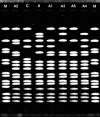Clonality and antimicrobial resistance gene profiles of multidrug- resistant Salmonella enterica serovar infantis isolates from four public hospitals in Rio de Janeiro, Brazil
- PMID: 16891490
- PMCID: PMC1594614
- DOI: 10.1128/JCM.01916-05
Clonality and antimicrobial resistance gene profiles of multidrug- resistant Salmonella enterica serovar infantis isolates from four public hospitals in Rio de Janeiro, Brazil
Abstract
In Brazil, Salmonella enterica serovar Infantis resistant to various antimicrobials, including cephalosporins, has been identified as an etiological agent of severe gastroenteritis in hospitalized children since 1994. In this study, 35 serovar Infantis strains, isolated from children admitted to four different Rio de Janeiro, Brazil, hospitals between 1996 and 2001, were characterized by pulsed-field gel electrophoresis (PFGE) and antimicrobial susceptibility testing in order to determine their genetic relatedness and antimicrobial resistance profiles. Thirty-four serovar Infantis strains were resistant to at least two antibiotic classes, and all 35 strains were susceptible to fluoroquinolones, cephamycin, and carbapenem. Extended-spectrum beta-lactamase (ESBL) screening by double-disk diffusion indicated that 32 serovar Infantis strains (91.4%) produced beta-lactamases that were inhibited by clavulanic acid. Antimicrobial resistance gene profiles were determined by PCR for a subset of 11 multidrug-resistant serovar Infantis strains, and putative ESBLs were detected by isoelectric focusing. Ten serovar Infantis strains carried bla(TEM), catI, ant(3")Ia and/or ant(3")Ib, sulI and/or sulII, and tet(D) genes as well as an integron-associated aac(6')-Iq cassette. Eight strains possessed at least four different beta-lactamases with pI profiles that confirmed the presence of both ESBLs and non-ESBLs. Our PFGE profiles indicated that 33 serovar Infantis strains isolated from Rio de Janeiro hospitals came from the same genetic lineage.
Figures


Similar articles
-
Characterization of a Salmonella enterica serovar Agona strain harbouring a class 1 integron containing novel OXA-type beta-lactamase (blaOXA-53) and 6'-N-aminoglycoside acetyltransferase genes [aac(6')-I30].J Antimicrob Chemother. 2004 Aug;54(2):354-9. doi: 10.1093/jac/dkh347. Epub 2004 Jul 1. J Antimicrob Chemother. 2004. PMID: 15231768
-
Molecular characterisation of multidrug-resistant Salmonella enterica serotype Infantis from humans, animals and the environment in Italy.Int J Antimicrob Agents. 2011 Nov;38(5):384-9. doi: 10.1016/j.ijantimicag.2011.07.001. Epub 2011 Aug 6. Int J Antimicrob Agents. 2011. PMID: 21821397
-
Characterization of Salmonella enterica isolates from infants and toddlers in Wuhan, China.J Antimicrob Chemother. 2009 Jan;63(1):87-94. doi: 10.1093/jac/dkn452. Epub 2008 Nov 4. J Antimicrob Chemother. 2009. PMID: 18984647
-
Holistic Strategies to Control Salmonella Infantis: An Emerging Challenge in the European Broiler Sector.Microorganisms. 2023 Jul 6;11(7):1765. doi: 10.3390/microorganisms11071765. Microorganisms. 2023. PMID: 37512937 Free PMC article. Review.
-
Cardiac Device-Related Infective Endocarditis Caused by Salmonella Infantis-Case Report and Review of Clinical and Epidemiologic Implications.Pathogens. 2025 May 14;14(5):474. doi: 10.3390/pathogens14050474. Pathogens. 2025. PMID: 40430794 Free PMC article. Review.
Cited by
-
Draft Genome Sequences of 26 Salmonella Isolates Associated with Multiple Outbreaks in Brazil.Microbiol Resour Announc. 2020 Mar 26;9(13):e00121-20. doi: 10.1128/MRA.00121-20. Microbiol Resour Announc. 2020. PMID: 32217679 Free PMC article.
-
Diversity of integron- and culture-associated antibiotic resistance genes in freshwater floc.Appl Environ Microbiol. 2012 Jun;78(12):4367-72. doi: 10.1128/AEM.00405-12. Epub 2012 Mar 30. Appl Environ Microbiol. 2012. PMID: 22467502 Free PMC article.
-
Antimicrobial Resistance and Virulence of Non-Typhoidal Salmonella from Retail Foods Marketed in Bangkok, Thailand.Foods. 2022 Feb 24;11(5):661. doi: 10.3390/foods11050661. Foods. 2022. PMID: 35267294 Free PMC article.
-
Investigation of the Genes Involved in the Outbreaks of Escherichia coli and Salmonella spp. in the United States.Antibiotics (Basel). 2021 Oct 19;10(10):1274. doi: 10.3390/antibiotics10101274. Antibiotics (Basel). 2021. PMID: 34680854 Free PMC article.
-
Antibiotic-Resistant Salmonella Circulation in the Human Population in Campania Region (2010-2023).Antibiotics (Basel). 2025 Feb 12;14(2):189. doi: 10.3390/antibiotics14020189. Antibiotics (Basel). 2025. PMID: 40001432 Free PMC article.
References
-
- Agência Nacional de Vigilância Sanitária (ANVISA). 2005. Manual de procedimentos básicos em microbiologia clínica para o controle de infecção hospitalar. [Online.] http://www.hu.usp.br/arquivos/Manualccih_2005.pdf.
-
- Alton, N. K., and D. Vapnek. 1979. Nucleotide sequence analysis of the chloramphenicol resistance transposon Tn9. Nature 282:864-869. - PubMed
-
- Altschul, S. F., W. Gish, W. Miller, E. W. Myers, and D. J. Lipman. 1990. Basic local alignment search tool. J. Mol. Biol. 215:403-410. - PubMed
-
- Angulo, F. J., K. R. Johnson, R. V. Tauxe, and M. L. Cohen. 2000. Origins and consequences of antimicrobial-resistant nontyphoidal Salmonella: implications for the use of fluoroquinolones in food animals. Microb. Drug Resist. 6:77-83. - PubMed
Publication types
MeSH terms
Substances
LinkOut - more resources
Full Text Sources
Medical
Research Materials
Miscellaneous

